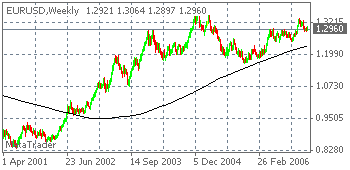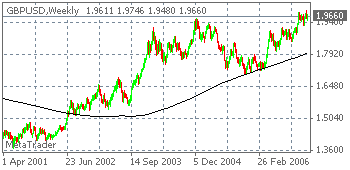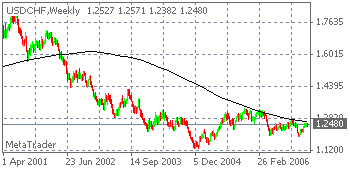The seven most liquid pairs are traded against the US dollar with the first four pairs being the majors, followed by three commodity pairs. Other currency pairs are better known as the currency crosses, most popular crosses are those that include the euro, they are EUR/JPY, EUR/GBP and EUR/CHF.
The major currency pairs are:
EUR/USD
USD/JPY
USD/CHF
GBP/USD
The commodity currency pairs are:
AUD/USD
NZD/USD
USD/CAD

Major Currency Pairs Personalities
EUR/USD
The most recent Bank for International Settlements (BIS) survey shows that the most traded major currency pair is the EUR/USD with 28% of total daily volume. The EUR/USD is great for new currency traders since it slow movement compared to the other major pairs. The EUR/USD tends to be negatively correlated to the USD/CHF and positively to the GBP/USD. (see weekly charts)

Characteristics
Average broker spread: 2-3 pips
Daily range average : 90-100 pips
Best time to trade: Euro Session (0700 GMT - 1700 GMT)
Some factors affecting the EUR/USD rate:
The major currency pairs are:
EUR/USD
USD/JPY
USD/CHF
GBP/USD
The commodity currency pairs are:
AUD/USD
NZD/USD
USD/CAD

Major Currency Pairs Personalities
EUR/USD
The most recent Bank for International Settlements (BIS) survey shows that the most traded major currency pair is the EUR/USD with 28% of total daily volume. The EUR/USD is great for new currency traders since it slow movement compared to the other major pairs. The EUR/USD tends to be negatively correlated to the USD/CHF and positively to the GBP/USD. (see weekly charts)

Characteristics
Average broker spread: 2-3 pips
Daily range average : 90-100 pips
Best time to trade: Euro Session (0700 GMT - 1700 GMT)
Some factors affecting the EUR/USD rate:
- The interest rate differential between the European Bank(ECB) and the Federal Reserve(FED)
- Dollar strongness drives EUR/USD lower
- FED intervention to weaken the dollar the sends EUR/USD higher
Trading the EUR/USD
Trading Experience: New and Advanced currency traders
Trading Style: Day trading and Swing trading
How to trade?
1) Applying Technical Analysis and/or Analyzing Fundamental News from the Euro and US zone to make EUR/USD trading decisions. Breaking strong psychological levels (1.3000, 1.2000,..) and/or surprising economic news releases can make the EUR/USD move a lot in one direction without much retracements.
2) Since the EUR/USD pair tends to be negatively correlated to the USD/CHF, it is always a good idea to compare both EUR/USD and USD/CHF charts in order to predict future moves, if USD/CHF breaks above an important resistance level and EUR/USD didn't break support level yet, the EUR/USD is very likely to break below support level. This also illustrates how USD/CHF tends to lead the move ahead of EUR/USD.
USD/JPY
The most recent Bank for International Settlements (BIS) survey shows that the USD/JPY with 17% of total daily volume is the second most traded major currency pair.

Characteristics
Average broker spread: 2-4 pips
Daily range average : 80-90 pips
Best time to trade: Asian Session (2400 GMT - 0900 GMT)
Some factors affecting the USD/JPY rate:
- The interest rate differential between the Bank of Japan(BoJ) and the Federal Reserve
- Japanese government intervention to strongen their currency sends USD/JPY lower
Trading the USD/JPY
Trading Experience: New and Advanced currency traders
Trading Style: Day trading and Swing trading
How to trade?
Applying Technical Analysis and/or Analyzing Fundamental News from the Asian zone to make USD/JPY trading decisions. Breakouts are often true and sustained ones.
GBP/USD
The most recent Bank for International Settlements(BIS) survey shows that the GBP/USD with 14% of total daily volume is the third most traded major currency pair. The GBP/USD is one of the most volatile currency pairs generating many false breakouts and wild movements, therefore, it is not recommend to start trading this pair unless you are a very experienced currency trader.

Characteristics
Average broker spread: 4-5 pips
Daily range average : 150-200 pips
Best time to trade: Euro Session (0700 GMT - 1700 GMT)
Some factors affecting the GBP/USD rate:
- The interest rate differential between the Bank of England(BoE) and the Federal Reserve
- High yield and attractive growth in the UK drives GBP/USD higher
Trading the GBP/USD
Trading Experience: Expert currency traders
Trading Style: Day trading and Swing trading
How to trade?
Applying Technical Analysis and/or Analyzing Fundamental News from the UK and US zone to make GBP/USD trading decisions. Watch out for false break outs! Surprising economic news releases can make the GBP/USD move a lot in one direction without much retracements.
USD/CHF
The most recent Bank for International Settlements (BIS) survey shows that the USD/CHF with 4% of total daily volume is the least liquid traded major currency pair. The USD/CHF tends to be negatively correlated to the EUR/USD.

Characteristics
Average broker spread: 4-5 pips
Daily range average : 120-135 pips
Best time to trade: Euro Session (0700 GMT - 1700 GMT)
Factors affecting the USD/CHF rate:
- Global stability and global recovery will send USD/CHF higher
- USD/CHF rallies on geopolitical instability
Trading the USD/CHF
Trading Experience: Moderate and Advanced currency traders
Trading Style: Day trading and Swing trading
How to trade?
1) Applying Technical Analysis Analyzing Fundamental News from the CHF and US zone to make USD/CHF trading decisions.
2) Since the USD/CHF pair tends to be negatively correlated to the EUR/USD, it is always a good idea to compare both EUR/USD and USD/CHF charts in order to predict future moves, if EUR/USD breaks above an important resistance level and USD/CHF didn't break support level yet, the USD/CHF is very likely to break below support level. This also illustrates how EUR/USD tends to lead the move ahead of USD/CHF.
